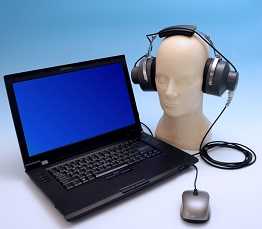Measuring How Well Earplugs Work
May 2015
DHHS (NIOSH) Publication Number 2015-181
A Story of Impact :

Photo by Mr. Scott Childress, US Army Aeromedical Laboratories.
Each year an estimated 22 million workers are exposed to noise loud enough to harm their hearing.1 The problem crosses many industries, including manufacturing, construction, agriculture, mining, and transportation. When noise levels cannot be reduced through engineering controls, the Occupational Safety and Health Administration (OSHA) requires that workers use hearing protection devices (HPDs) to protect themselves from the damaging effects of noise. Despite decades of OSHA-mandated HPD use, noise-induced hearing loss (NIHL) remains highly prevalent.
All HPDs sold in the U.S. are evaluated in a test laboratory and labeled with a Noise Reduction Rating (NRR). However, studies have repeatedly demonstrated that the NRR does not accurately predict noise reduction performance for an individual in the workplace. Research shows that most workers achieve less than half of the sound attenuation predicted by the NRR.2 The difference between the NRR and actual worker attenuation varies widely across different types of protectors and different ear canal sizes and shapes. Personal hearing protector fit-testing is the only way to know how much noise reduction an individual receives and to ensure that each worker is sufficiently protected from excessive noise.
The National Institute for Occupational Safety and Health (NIOSH) developed the HPD Well-Fit™ system to create a fast and reliable fit-test system not anchored in proprietary technology. HPD Well-Fit™ measures the amount of sound reduction an individual worker receives from their HPD and identifies workers who are not sufficiently protected. HPD Well-Fit™ requires only a computer running the Windows operating system (version 7 or later) with a high-definition sound card, a mouse with a scroll wheel, and sound-isolating headphones. It can be used to test any type/brand of earplug and provides results within 7 to 10 minutes. HPD Well-Fit™ expedites the collection of repeat measurements, so retraining and retesting can be conducted in just 2 to 5 minutes. The HPD Well-Fit™ system is fully customizable, allowing the user to select which frequency bands (125 to 8000 Hertz) are tested and choose the best protection for different noise conditions.
Impact
As a result of its unique capabilities, HPD Well-Fit™ makes hearing protector fit-testing easy and feasible for even the most basic hearing loss prevention program. Fit-testing measures the noise reduction an HPD provides for an individual worker and calculates that worker’s Personal Attenuation Rating (PAR) - identifying those at risk for developing hearing loss due to poor earplug fit while eliminating the need to derate the NRR. Universal implementation of hearing protector fit-testing could help to reduce the incidence of hearing loss among noise-exposed workers who must still use HPDs.
NIOSH has licensed HPD Well-Fit™ for sale and production as FitCheck Solo by Michael & Associates. As a result of this technology transfer, more than 90 fit-testing systems have been sold in the United States and Canada allowing companies like Vale and Quaker to identify employees who have low attenuation. The State of Washington Department of Transportation’s safety personnel have implemented fit-testing. Custom Protect Ear has developed training materials, and developed call center support for using FitCheck Solo as a part of hearing loss prevention efforts and has partnered closely with Michael & Associates to promote fit-testing. In 2008, the NIOSH-OSHA-NHCA Alliance published a joint document recommending fit-testing as a best practice in hearing loss prevention programs.3 With the development of HPD Well-Fit™, fit-testing has been validated as an effective, practical and essential tool for preventing occupational hearing loss.
Relevant Information
- About 22 million workers in the U.S. are exposed to hazardous noise each year.
- Noise is considered hazardous when it reaches 85 decibels or higher, or if a person has to raise their voice to speak with someone 3 feet away.4
- Hearing protection devices (HPDs) often fail to protect workers from hearing loss because of poor fit.
- HPD Well-Fit™ can test the noise reduction of any earplug and is inexpensive, fast, and portable.
View/Download Entire Document: Measuring How Well Earplugs Work [PDF - 808 KB]
![]()
![]()

![]()
Visit the NIOSH Web site (www.cdc.gov/niosh/topics/noise) for more information about the NIOSH HPD Well-FitTM system. Authors of Field Attenuation Measurement for Hearing Protection Devices—William Murphy, Mark Stephenson, David Byrne, Christa Themann; NIOSH—received a 2013 Bullard-Sherwood r2p Award in the Technology category.
References
- Tak SW, Davis RR, Calvert GM [2009]. Exposure to hazardous workplace noise and use of hearing protection devices among U.S. workers: NHANES, 1999–2004. Am J Indust Med 52:358–371.
- Berger Franks and Lindgren 1996, International Review of Field Studies of Hearing Protector Attenuation, in Scientific Basis of Noise-Induced Hearing Loss Eds A Axelsson, H Borchgrevink, RP Hamernik, P Hellstrom, D. Henderson, RJ Salvi, Thieme Medical Pub In. (New York, NY)
- NHCA – NIOSH – OSHA Alliance (2008). Best Practice Bulletin: Hearing Protection - Emerging Trends: Individual Fit Testing, 1–3.
- NIOSH Occupational Hearing Loss Surveillance [2015]. Topic page for Occupational Hearing Loss Surveillance, http://www.cdc.gov/niosh/topics/ohl/ last accessed March 10, 2015.
The use of trade names and commercial sources is for identification purposes only and does not imply endorsement by the National Institute for Occupational Safety and Health (NIOSH), the Centers for Disease Control and Prevention (CDC), or the U.S. Department of Health and Human Services (HHS) or imply that one product is preferred by NIOSH, CDC, or HHS over other products manufactured by other companies.
- Page last reviewed: May 13, 2015
- Page last updated: May 13, 2015
- Content source:
- National Institute for Occupational Safety and Health Division of Applied Research and Technology (DART)


 ShareCompartir
ShareCompartir